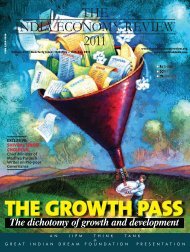Download - The India Economy Review
Download - The India Economy Review
Download - The India Economy Review
Create successful ePaper yourself
Turn your PDF publications into a flip-book with our unique Google optimized e-Paper software.
P LANNING P ARADIGM<br />
sectors which are pillars of growth, name-<br />
ly the capital goods producing industries<br />
(Bhagwati and Desai, 1970). <strong>The</strong> policy of<br />
stressing more the capital goods and basic<br />
goods industries showed up in increased<br />
share of these sectors in the industrial<br />
structure during the twenty fi ve years<br />
from mid-fi fties to eighties. But this pe-<br />
riod also witnessed one of the worst indus-<br />
trial recessions which is believed largely<br />
due to demand side constraints- a mis-<br />
match between the rapid growth of capital<br />
and basic goods whose market did not rise<br />
that fast due to slower growth in the sec-<br />
tors which used them. <strong>India</strong>n economy<br />
recovered from this, and in the long run<br />
proved the believers in the low level equi-<br />
librium trap wrong. But the increasing<br />
transaction costs due to the rent seeking<br />
behaviour ingrained in the license permit<br />
raj made the whole policy of state control-<br />
led industrialisation inconsistent with the<br />
need of the hour.<br />
<strong>The</strong> larger issue which bothered the<br />
average <strong>India</strong>n was the slow rate of<br />
growth of the <strong>India</strong>n economy during<br />
1950-80, which averaged a paltry 3.5 per-<br />
cent per annum. <strong>The</strong> offi cial statistics did<br />
show reduction of both urban and rural<br />
poverty, but a slowly growing economy<br />
could not expect a dramatic change in<br />
income distribution, especially when the<br />
trickle down strategies are always subject<br />
to heavy skepticism. Nonetheless, <strong>India</strong><br />
succeeded in staving off a possible food<br />
crisis through the much acclaimed green<br />
revolution. However, over the years agriculture<br />
sector faced more misery, while<br />
126 THE IIPM THINK TANK<br />
the infrastructure in the economy got increasingly<br />
neglected. <strong>The</strong> public sector<br />
increasingly got overshadowed by the<br />
private sector in the gross capital formation<br />
of the nation. We will take up these<br />
issues in the next sections to highlight a<br />
desirable future road map for the plan-<br />
<strong>Economy</strong> recovered from this, and in<br />
the long run proved the believers in<br />
the low level equilibrium trap wrong<br />
ning process in <strong>India</strong>.<br />
Policies to Resurrect a Crisis<br />
Prone Agriculture Sector<br />
Speaking of agriculture, the fi rst twenty<br />
years of planning in <strong>India</strong> was primarily<br />
geared towards ensuring food security<br />
among other goals. <strong>The</strong> per capita availability<br />
of cereals increased from 334.2<br />
grams per capita per day in 1951 to 419.1<br />
grams in 1972. One could not minimize<br />
the importance of green revolution in this<br />
regard. However, over the years public<br />
investment in agricultural gross capital<br />
formation has declined steadily over the<br />
years. <strong>The</strong> agriculture in <strong>India</strong> still depends<br />
heavily on good monsoon, but the<br />
allocation on irrigation and fl ood control<br />
in the government budget has steadily<br />
declined over the years and now hovers<br />
around 0.1 to 0.2 percent annually compared<br />
to around seven to eight percent<br />
in the 60s to 80s. This is the major area<br />
where the government involvement<br />
was perceptible in historical backdrop.<br />
<strong>The</strong> rest of the inputs were<br />
more or less privately provided except<br />
fertilizer. <strong>The</strong> paradox is that in<br />
<strong>India</strong>, as in elsewhere, public investment<br />
in rural infrastructure acts as<br />
a major complementary factor to<br />
private capital formation (World Bank,<br />
2003).<br />
One of the net results of this apathy<br />
towards agriculture is a fall in the total<br />
factor productivity (TFP) in agriculture in<br />
the last two decades. TFP measures the<br />
quality and effi ciency of the inputs (including<br />
managerial effi ciency) and not<br />
the quantity. Incidentally, TFP growth<br />
was around 1.39 percent in the 1970s and<br />
1.99 percent in the 1980s compared to<br />
-0.59 percent per year in the fi rst half of<br />
the 1990s (Srinivasan, 2000). <strong>The</strong> per<br />
capita per day cereal and pulse availability<br />
also do not show any promising trend<br />
in recent years although some claim the<br />
change in food habits might reduce the<br />
need of cereals and pulses over time. <strong>The</strong><br />
overall scenario does not look promising<br />
as the agricultural growth has fallen signifi<br />
cantly over the years and lately turned<br />
negative for some years.





